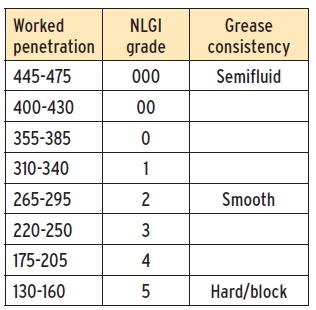It’s all in the numbers (But can we believe them?)
Dr. Robert M. Gresham, Contributing Editor | TLT Lubrication Fundamentals October 2015
Being consistently consistent is trickier than it sounds.

www.canstockphoto.com
KEY CONCEPTS
•
The first goal in manufacturing is to make a given product or part as consistent as possible.
•
The second goal is to make what we want and that it meets the specification or requirement.
•
Departments and outside test labs must be able to generate the same measurement numbers on the same samples within the confines of the test methods.
IN MANUFACTURING, THE FIRST GOAL IS TO MAKE A GIVEN PRODUCT or part as consistent as possible—that is, always the same. Second is to make what we want—that is, does it meet our specification or requirement? Clearly the two concepts go hand in hand: Did we make what we wanted, and is it the same every time? Finding the answer can be easier said than done.
First, did we make what we wanted? Well, sometimes a customer might set a specification or requirement for something beyond our or maybe even the world’s capability. I’ve had customers actually tell me that they wanted the specification that way because they wanted me to do the best that I could. Well, that may sound good, but in the business world, not so good. If you agree to meet a specification and can’t, you end up not meeting the requirements of the sales contract—and you might not get paid. Agreeing to an unrealistic specification just to get a sale might help a salesman’s numbers, but it won’t endear him to the manufacturing department, accounting department or, especially if it results in a lawsuit, the CEO. Think about job security.
The second issue is a little more complex. How do you know you are making the product the same way every time and to the specification? This gets us to the issue of measurement. In the specification (and/or sales contract), not only should you agree on what is to be made but also how to measure that it has been made properly. When you make the measurement, will you get the right number?
This is where organizations like International Standards Organization (ISO) or American Society for Testing and Materials (ASTM,
www.astm.org) come in. They, working with a cross-section of industry, develop standards for materials and test methods. Regarding test methods, ASTM shepherds the development of test procedures and equipment for measuring something, verifies the precision and accuracy of the test and publishes a standard to codify the test method.
Accuracy has to do with “did you get the correct measurement value?” Bias is a systematic error that contributes to the difference between the mean of a large number of test results and an accepted reference value. The “accepted reference value” is considered the true value and, therefore, bias has to do with the degree to which that true value is not obtained. In general, through calibration bias can be reduced or eliminated. Precision has to do with the inherent variability of the test method itself. Does the method provide the same number every time, or does it vary—and, if so, by how much? In ASTM parlance, precision is stated in its published standards as the repeatability and the reproducibility of the method. Repeatability has to do with the difference between two test results performed by the same operator in the same laboratory with the same apparatus and on the same test material under constant operating conditions. Reproducibility has to do with the difference between two single and independent results obtained by different operators working in different laboratories with different test equipment on identical test material in the normal and correct operation of the test method.
Thus, when a specification is written and/or sales contract agreed to, these are important considerations. The following story is an example.
I once had a grease customer who wanted the consistency of the grease we sold him to be very consistent (pun intended). Grease consistency is a somewhat ethereal word to describe the apparent thickness, soupiness or whatever of the grease. ASTM D217-10 describes the test method for measuring consistency of greases (
see Table 1).
Table 1. Categorizing Consistency in Greases

I suppose a very inconsistent grease is like a brick and a very consistent grease is like a thick fluid—since the numbers go up—but that seems counterintuitive. But I digress. Anyway, people refer to grease consistency by its National Lubricating Grease Institute (NLGI) ranking as shown in Table 1. As I recall, the customer specified the grease at 305 +/- 5. The product wasn’t much; we merely mixed an inert solid lubricant into base grease that we purchased according to his specification. The base grease was an NLGI No. 1 (
see Table 1). As you can see, a No. 1 can vary from 310-340, but what about a 305? After we mixed the additive, the consistency decreased a little (got thicker) and was on the low end of a No. 1.
However, to address the issue of how consistent the consistency of our grease was, one should look to the ASTM method, D217-10 concerning the variability of the test method itself (
see Table 2).
Table 2. Repeatability and Reproducibility

It states that the methods worked penetration variability for more than one lab and operator is 23 units. Thus, we—the customer and I—could vary by 46 units (+/- 23) and statistically have the same result. As you can guess, with a specification of +/- 5, we could test the same batch and sample of the grease and at least 82% of the results would be out of specification. Thus, he could, and did, frequently reject a lot and send it back. We could have simply relabeled it, sent it back and 23% of the time it would have met the specification. If this sounds like a recipe for disaster, it is only because it was.
Clearly, in the design and specification of various systems, consideration of our ability to measure and verify the components that make up the system needs to be given priority at the very beginning. Both customer and vendor quality assurance departments and/or outside test labs need to be able to generate the same numbers on the same samples within the confines of the test methods being employed. Salesmen should not accept orders for the impossible just to make their sales numbers. After all, it’s
all in the numbers.
 Bob Gresham is STLE’s director of professional development. You can reach him at rgresham@stle.org
Bob Gresham is STLE’s director of professional development. You can reach him at rgresham@stle.org.